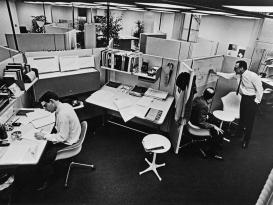This project examines spatial practices of sound regulation in the large open-plan offices that proliferated after World War II in Europe and North America. The principal users of these workspaces were postindustrial “knowledge workers,” so named by the Austrian-American management guru Peter Drucker. Businesses’ expectation—influenced by cybernetic theories of communication and creativity—was that these employees would accomplish cognitively demanding work while sitting in an open field of desks, pervaded by the sounds of talking and various office machines. As a result, the acoustic regulation of open offices soon became fraught with managerial ambitions of promoting the free flow of ideas and with worker anxieties about diminishing autonomy and privacy. The research focuses on the 1960s and 1970s, when designers began using acoustically absorbent materials and carefully-placed white noise generators to create a variegated “blanket” of sound in which regions of clear audibility were punctuated by pockets of sonic privacy. Through this selective distribution of noise and quiet, they endeavored to tune the office’s accommodation of collaborative and autonomous work modes. At stake in this project are the status of sound and noise in postwar ideologies of communication, the ambient environments of immaterial labor, and the migration of acoustic ideas between regional contexts and across the disciplines of architecture, acoustic engineering, space planning, and furniture design.

The first Herman Miller Action Office II installation, for JFN Associates, Chicago (1969).
Project
(2018)
